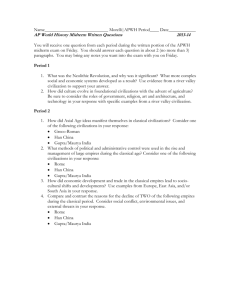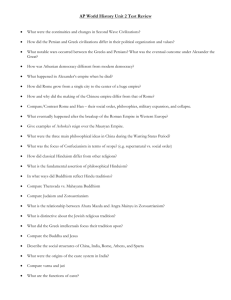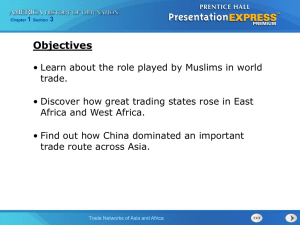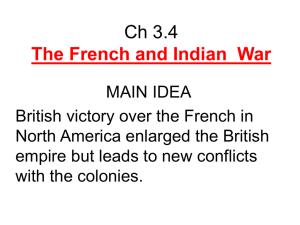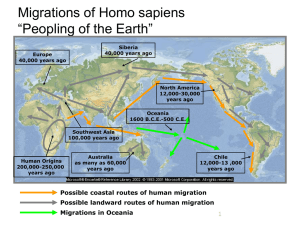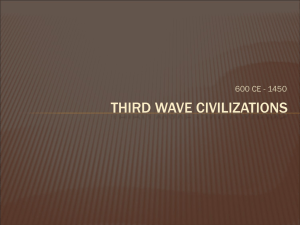2013-2014 WHAP Practice Test: First semester KEY FIX 5, typos 20
advertisement
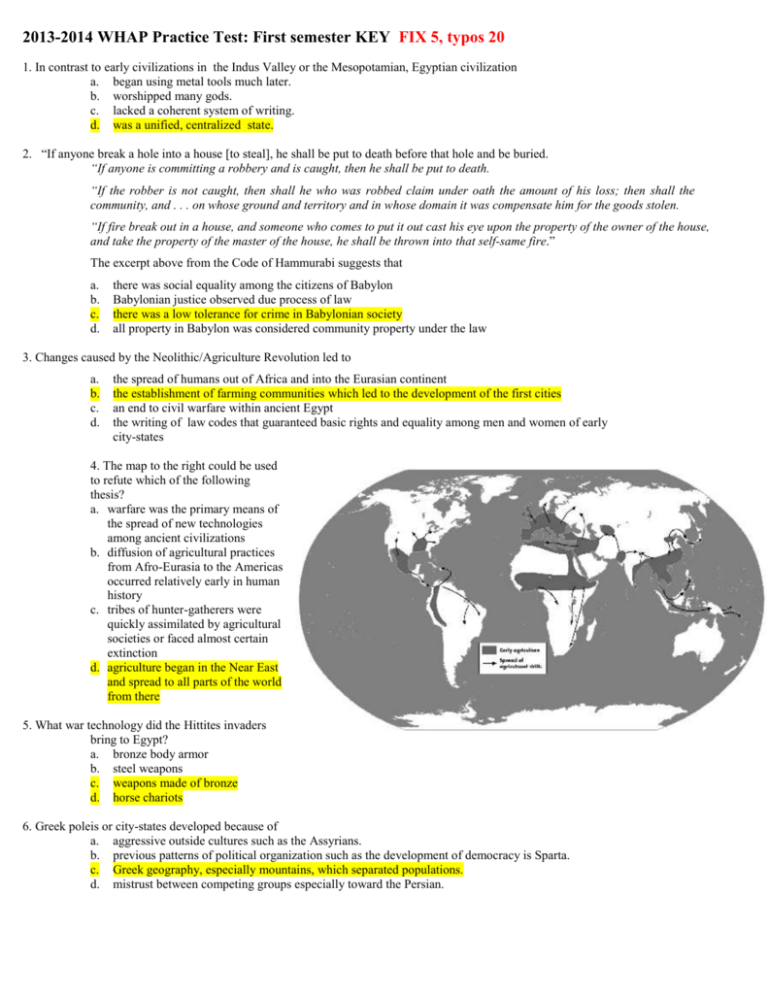
2013-2014 WHAP Practice Test: First semester KEY FIX 5, typos 20 1. In contrast to early civilizations in the Indus Valley or the Mesopotamian, Egyptian civilization a. began using metal tools much later. b. worshipped many gods. c. lacked a coherent system of writing. d. was a unified, centralized state. 2. “If anyone break a hole into a house [to steal], he shall be put to death before that hole and be buried. “If anyone is committing a robbery and is caught, then he shall be put to death. “If the robber is not caught, then shall he who was robbed claim under oath the amount of his loss; then shall the community, and . . . on whose ground and territory and in whose domain it was compensate him for the goods stolen. “If fire break out in a house, and someone who comes to put it out cast his eye upon the property of the owner of the house, and take the property of the master of the house, he shall be thrown into that self-same fire.” The excerpt above from the Code of Hammurabi suggests that a. b. c. d. there was social equality among the citizens of Babylon Babylonian justice observed due process of law there was a low tolerance for crime in Babylonian society all property in Babylon was considered community property under the law 3. Changes caused by the Neolithic/Agriculture Revolution led to a. b. c. d. the spread of humans out of Africa and into the Eurasian continent the establishment of farming communities which led to the development of the first cities an end to civil warfare within ancient Egypt the writing of law codes that guaranteed basic rights and equality among men and women of early city-states 4. The map to the right could be used to refute which of the following thesis? a. warfare was the primary means of the spread of new technologies among ancient civilizations b. diffusion of agricultural practices from Afro-Eurasia to the Americas occurred relatively early in human history c. tribes of hunter-gatherers were quickly assimilated by agricultural societies or faced almost certain extinction d. agriculture began in the Near East and spread to all parts of the world from there 5. What war technology did the Hittites invaders bring to Egypt? a. bronze body armor b. steel weapons c. weapons made of bronze d. horse chariots 6. Greek poleis or city-states developed because of a. aggressive outside cultures such as the Assyrians. b. previous patterns of political organization such as the development of democracy is Sparta. c. Greek geography, especially mountains, which separated populations. d. mistrust between competing groups especially toward the Persian. 7. The geography and environment of the Andean region a. did not require the use of planned labor systems b. required societies to use a variety of innovative methods including terraced farming, animal domestication, and longdistance trade to meet all their needs. c. formed one type of ecological zone. d. allowed societies to do very little because the climate was naturally suited to produce ideal agricultural conditions. 8. Women in Mesopotamian society had a lower status than in a hunter-gatherer society because of a. their role in the military. b. their role as primary agricultural producers. c. the requirement to serve as sacrifices. d. the shift of the major role in food provision from women to men. 9. Which statement best completes the causeeffect chart to the right? a. Egyptian Civilization: Pharaoh, Politics, and Pyramids b. River Valley Civilizations: Complex Governments and Technology c. Indus River Valley Civilization: Sewage System and Urban Planning d. River Valley Civilizations: Diseases and Trade Routes . Fertile River Valleys Isolating Mountain Ranges Dependable Monsoon Weather Patterns Trade with Mesopotamia 10. The geographic factors listed above led to the development of which highly complex and distinctive civilization by the year 600 CE? a. Sumer b. Egypt c. China d. Indus 11.Classical civilizations differed from river valley civilizations in all of these ways EXCEPT a. government was larger and more complex. b. classical religions were mainly centered around nature. c. interregional contacts, especially through trade, war, or migration, increased. d. their social institutions were more complex. . 12.Which choice best explains the main differences between Legalist and Confucian beliefs? a. legalism emphasized equality between individuals while Confucianism was more concerned with establishing a strong merchant class. b. legalism focused on maintaining balance through observation of nature. c. legalism shaped private lives while Confucianism was a more political doctrine d. legalism relied on harsh laws to maintain order while Confucianism depended on rituals, proper conduct, and obligations of every individual. 13.Which was NOT a method by which the Persians strengthened their empire? a. Establishing a state religion and outlawing any others b. Building roads and highways to connect the far-flung reaches of the empire c. Giving autonomy to provincial administrators d. Using technology and learning from other cultures 14.The major impact of Alexander the Great’s conquests was the a. destruction of regional trade and commerce. b. spread of Greek culture throughout the eastern Mediterranean. c. birth of mystery religions and the forced migration of the Jews. d. elimination of foreign influences from Greek culture. 15. It can be inferred from the map that in the ancient Harappan civilization, the Indus River most likely served as a a. political boundary b. defensive barrier c. mountain pass d. trade route 16. The following statement reflects which of the following belief systems? “A country of a thousand war-chariots cannot be administered unless the ruler attends strictly to business, punctually observes his promises, is economical in expenditure, shows affection towards his subjects in general, and uses the labor of peasantry only at the proper times of the year” a. b. c. d. Confucianism Christianity Daoism Legalism 17. a. b. c. d. In the early period of Roman expansion, the main power in the western Mediterranean were the: Han Persians Greeks Carthaginians 18. For an early form of writing, the Shang Dynasty made use of: a. b. c. d. sheep entrails animal bones clay tablets papyrus reeds 19. Which of the following statements explains the significance of the Mandate of Heaven in the passage to the right a. The Mandate of Heaven was China’s state religion. b. The Mandate of Heaven required ritual sacrifice to hold power. c. The Mandate gave Chinese dynasties political authority to rule. d. The Zhou people rebelled against the Mandate of Heaven. “Those who in private life behave well towards their parents and elder brothers, in public life seldom show a disposition to resist the authority of their superiors. And as for such men starting a revolution, no instance of it has ever occurred.” 20. According to this quote, it is important that a. Children know the importance of communicating with their ancestors in the afterlife b. Public order be maintained by a strong central government c. individual know their responsibly in society d. male children be expected 21.Which of the following best explains the spread of alphabetic language, as opposed to cuneiform or hieroglyphic, through the Mediterranean region? a. b. c. d. the trading network of the Phoenicians the continued influence of Mesopotamian empires the conquest of north Africa by Minoans the invasion of the Near East by Mycenaeans 22.Which of the following explains why the western portion of the Roman Empire suffered more in the breakdown of the empire? a. The Church in the eastern portion attracted more people. b. The Catholic Church abandoned the western portion of the empire. c. The feudal system in the west relied on trade with the Americas. d. The eastern portion was located close to existing trade routes in Mesopotamia. 23.The greatest change caused by the gradual adoption of agriculture was a. major migrations to the temperate zones. b. a major die-off of wild species. c. a global population decrease. d. a global population increase. 24.Which of the following was the largest geographic challenge for the people settling in Mesopotamia? a. the absence of useful building materials b. the unpredictable nature of the river system c. the absence of domesticated animals d. the great distance to develop trade with other civilizations. 25. Which of the following would be the best title for the list to the right? a. Ways that the Shang Dynasty adapted b. Contributions of the Sumerians c. Contributions of the Egyptians d. Customs of the Indus River Valley Civilizations 26. Which of the following is NOT one of the ways the Confucianism attempts to create social and political harmony? a. By emphasizing the goodness of human nature and seeking to promote it through education, especially of public officals b. By avoiding violence and promoting justice, loyalty and dignity c. By emphasizing individual freedom, rugged individualism and independence d. By emphasizing the idea that the structure of the government is parallel to the family. 27. Which of the following would best describes the map to the right: a. agricultural regions of early civilizations b. the greatest extent of the Ottoman Empire c. the diffusion of iron tool-making d. areas dominated by early nomadic war-bands 28.Which of the following foundational civilizations is NOT correctly matched with its location? a. Mohenjo-Daro - Indus River Valley b. Egypt - Nile River Valley c. Shang - Huang He Valley d. Chavin - Mesoamerica 29. Why were nomadic pastoralists important to settled agriculturalists? a. They served as a buffer between agricultural communities and outside enemies. b. They left important records that influenced agricultural innovation. c. They had so little interaction with agricultural communities that farmers came to think of them as powerful mythological beings. d. They transmitted ideas, products, and peoples across long distances, linking them with a wider world. 30. The African proverb, "Until the lions have their historians, tales of hunting will always glorify the hunter," conveys which of the following? a. Common people need to learn how to write so they can tell their story. b. Hunting is a sport that only brings glory to the hunter. c. History usually reflects the viewpoint of the victors. d. The concept of history is much different in Africa than it is in Europe or the United States. 31. As systems of record keeping such as Cuneiform were developed, they tended to a. become more complicated to reflect the new complexities of urban life. b. simplify in order to appeal to more people as they spread over wider areas. c. result in lower literacy rates among civilized people. d. be used exclusively by lower class workers to document daily living. 32. The photograph above of a ziggurat (first erected in Mesopotamia ca. 2200 BCE) best exemplifies which of the following historical processes? a. Development of novel cultural blending b. Growth in state power through military conquest c. Promotion of culture through the arts d. Use of monumental architecture to project political power 33. An example of the economic effect on human societies as a result of the Neolithic Revolution is a. the move towards a classless society b. an equal distribution of wealth among farmers c. the end of the practice of loaning money d. the specialization of labor 34.“Another strong proof that this disease is no more divine in origin than any other is that it afflicts those who are by nature phlegmatic [produce too much phlegm], but it does not attack the bilious [people who produce too much bile]. If this disease were more divine than others, it should afflict all groups equally....” The quotation above by Greek physician Hippocrates (ca. 460 BCE - ca. 370 BCE) best expresses the Greco-Roman idea that a. the gods were always responsible for human suffering b. science should employ logic and empirical observation c. trade routes were major causes of the spread of disease d. cities needed to be prepared for all sources of disease 35.Trade in both the Indian and Atlantic Oceans greatly improved as a result of a. advanced knowledge of the winds and currents b. the spread of disease pathogens c. increased use of domesticated pack animals d. a decreased desire for luxury goods. 36. This statue of the Buddha to the right highlights the a. lack of Chinese impact on the spread of Buddhism b. continuous interactions among Hindus and Buddhists c. influence of Hellenistic culture along the Silk Roads d. growing authority of shamanism in Eurasia by ca. 600CE 37. Regardless of the spread of more organized religions and belief systems, shamanism and animism remained a major forces in the lives of people living between ca. 600 BCE and ca. 600 CE because a. the rise of logic had been thoroughly dismissed b. none of the universal religions had developed c. there was a decline in beliefs concerning magic and otherworldliness d. people continued to rely on the natural world 38.The role of women in all imperial societies during the period between 600BCE-600CE: a. improved among elites as a result of increased food production b. was limited due to the overarching belief in patriarchy c. slowly declined following massive plague pandemics d. declined among peasants as a result of an increased wealth gap 39.As Christianity spread to throughout Latin America and Africa, it adapted by a. introducing the use of prayers during religious services b. incorporating objects and customs of worship from local religions c. requiring dietary restrictions similar to those found in Judaism d. embracing the native people’s pantheon of local gods 40.As a result of conquests by the Assyrian, Babylonian, and Roman Empires, the Jewish people a. embraced the idea that desire and suffering can only be cured through enlightenment b. were forced to settled in diasporic communities around the Mediterranean and Middle East c. gradually converted to a polytheistic belief system. d. began to seek a balance between humans and nature in order to achieve their freedom 41. Innovations in maritime technology, such as the development of dhow ships (image to the right) resulted in a. the ability to sail across the Atlantic and explore the Americas b. a massive decline in the use of overland trade routes c. a mass migration of people across the major ocean basins d. more frequent exchanges in the Indian Ocean Basin. 42. As Buddhism spread throughout Central and East Asia it transformed as a. it slowly adopted the caste system as a defining characteristic b. people began to see the Buddha himself as a god c. traders adopted the idea of the eightfold path as a way for commercial gain d. the Chinese government integrated it into the Confucian ideology 43. With the introduction of saddles and other new technologies that could be used to control domesticated pack animals, a. expenses significantly increased along the major trading networks b. nomadic peoples came to dominate civilized peoples politically and economically c. overland trade routes became longer and connected more people d. water-based trade steadily decreased both in terms of cargo size and type 44. Which of the following changes best justifies the claim that 6th century BCE marks the beginning of a new period of world history? a. The development of trade between Mesopotamia and the Indus River Valley b. The decline and collapse of the Roman, Han, and Gupta Empires c. Important developments in Judaism, Daoism, Confucianism, Buddhism, and Platonism d. The rise of river valley civilizations 45.The spread of Buddhism, Islam, and Christianity was similar in that a. The practices of each belief system became even more tightly regulated in order to retain a strong connection to their original homelands b. Each belief system dramatically changed their fundamental tenets in order to gain new adherents c. All spread successfully due partly to merchants travelling d. All were reactions to an existing belief system 46.As migrations occurred, such as the spread of Arabs out of the Arabian Peninsula, the migrating peoples tended to a. abandon all cultural values that were present in their native lands b. adopt the religions of the locals in the regions to which they were immigrating c. completely destroy all native cultures in the paths of their migrations d. spread their languages to the new regions they began inhabiting 47.The diffusion of crops to more populated areas, such as the spread of bananas to Africa, was caused by the a. decline of religious objections to newly discovered foodstuff b. increasing role played by empires in the period between 600 and 1250 c. role of trade routes in bringing goods to new parts of the world d. spread of pandemic diseases 48.As a result of technological innovations, such as the horse collar and the chinampa system, a. famine became a continuous source of fear b. agricultural productivity increased dramatically c. urban populations saw significant decline d. sea-based trade gained dominance over land-based trade 49.The migration of the Polynesian peoples brought with it the a. transmission of iron technologies b. spread of domesticated animals c. growth of large-scale land based empires d. decline of major trade routes 50. Between 800 and 1200, feudalism was the governmental form shared by which of the following pairs of regions? a. Japan and Mesoamerica b. Northern Europe and the Middle East c. Western Europe and Japan d. Sub-Saharan Africa and the Middle East 51. Unlike slavery, serfdom resulted in people a. who were not owned as chattel b. with fewer rights than free peasants c. who had their freedom of movement restricted d. who gained protection from their masters 52. The beliefs and practices of Islam were based on interactions between Arabian peoples and all of the following groups EXCEPT a. Jews b. Zoroastrians c. Buddhists d. Christians . a. b. c. d. 53. The development of Angkor Wat, (image right) reflects the blending of Hindu and Christian cultures Muslim and Hindu Muslim and Buddhist Buddhist and Hindu cultures 54. In the 16th century, Europeans sought sea routes to Asia mostly because the land routes were a. controlled by Muslim empires b. destroyed by floods c. ruined by avalanches d. blocked by Crusaders 55.. One reason for the success of the Reformation in Europe was a. Martin Luther’s execution, which made Europeans angry b. the Spanish Inquisition, which frightened people into change c. the Crusades, which converted many Muslims to Christianity throughout Europe d. the invention of the printing press, which made possible the rapid spread of ideas 56. The passage above discusses the marriage of Queen Isabella and King Ferdinand. What else is being described in this passage? a. The Spanish Reconquista b. a crusade to the Holy Land c. the start of the Italian Renaissance d. the reasons for the voyages of Columbus 57/ The statement above was most likely used to encourage people to a. join the Crusades b. repel a Viking invasion c. force Russians to convert to Catholicism d. stop advancement of the Huns in Europe 58. According the excerpt to the left, what role did the Church play in the lives of the people during the Middle Ages in Europe? a. It was a guide to understand government and politics. b. It explained their duty and relationship to the land. c. It often controlled all aspects of their daily life. d. It only explained the importance of salvation. 59. The Twelve Tables of Rome and Hammurabi’s Code were both – a. writing techniques taught in Roman schools b. codified legal systems that sought to unify an empire c. royal mandates that proclaimed the divine nature of the emperor d. sacred religious texts instructing citizens how to live a moral life 60.Which of the following conclusions is supported by information provided by the given map? a. India connected to both trade routes. . b. Traders depended mainly on rivers as avenues of transportation. c. More products were carried on the ocean than across the land. d. Silk was the principal product traded. 61. Which of the following best explains why the Chinese built the Great Wall and the Grand Canal? a. The Great Wall and the Grand Canal were built to discourage Chinese peasants from emigrating. b. The Great Wall was built to protect against invasions, while the Grand Canal was meant to provide an alternative transportation route between the north and the south. c. The Great Wall and the Grand Canal were constructed to restrict the exchange of goods with foreign merchants. d. The Great Wall was constructed to protect farming villages from seasonal floods, while the Grand Canal was meant to improve access to coastal cities. 62. Which economic principle shown on the map above helped contribute to the success of Europe’s Commercial Revolution? a. manorialism b. socialism c. mercantilism d. barter system 63.In the 1500s, European merchants arriving in China were restricted to the ports of Macao and Canton and were required to pay in either gold or silver. This reflects which of the following? a. That Ming emperors needed precious metals to pay for the expansion of their navy. b. That European monarchs feared for the safety of merchants traveling into the interior of China. c. That Chinese farmers would suffer if cash crops from the Americas were allowed to enter the country. d. That European manufacturers were unable to produce goods that were valued in China. 64. The map to the right demonstrates that the Ottoman Empire a. originated in Hungary and spread to the surrounding areas b. had a strategic location for trade between Europe and Asia c. was totally landlocked, with no access to the sea d. had control over most of western Europe by 1566 65.All of the following were impacts of the Atlantic Slave Trade on West Africa EXCEPT a. Trade in slaves for European guns promoted warfare between African states, giving new power to some b. the slave trade increased the demand for African slaves by Europeans, as demand for European manufactured goods increased c. Christianity was introduced to West Africa d. Europeans took over political control of most of Sub-Saharan Africa 66.The largest demographic impact of the Atlantic Slave Trade on West Africa was a. the inhumane treatment of Africans on the slave ships b. A gender imbalance in Africa and the Americas c. total loss of African culture in Africa and in the Americas d. the increase of indentured servants to the Americas 67. What was significant about the use of the astrolabe and magnetic compass by Europeans? a. It gave European sailors a false sense of confidence in their navigation abilities. b. It allowed Arab traders in East Africa to transport large numbers of slaves to Africa. c. It gave European sailors a large advantage over Chinese sailors in navigation abilities. d. It allowed European nations to undertake transoceanic voyages without fear of getting lost. 68.What was a political impact of the Reformation? a. The Holy Roman Catholic Empire strengthened, and the church influenced nearly all aspects of daily life b. The systems of feudalism and manorialism grew and spread rapidly throughout Europe c. Europe becomes politically fragmented, and the Crusades begin. d. Europe becomes politically fragmented along religious lines, and nations aligned themselves as Catholic or Protestant 69. What was the effect of the extensive Mongol Empire on the people who lived in Europe and Asia in the 1200s? a. development of a common language b. adoption of Confucian ideas and practices c. significant increases in trade between the regions d. expansion of Japanese cultural traditions across the regions 70. Which statement about the Silk Road is most accurate? a. Italian and Greek merchants dominated trade along the Silk Road. b. Governments of adjoining regions constructed the Silk Road. c. Buddhism first spread to China and then Japan along the Silk Road. d. The Mongol Empire blocked trade along the Silk Road. 71.One reason the ancient kingdoms in western Africa prospered was that they a. were located along the Tigris and Euphrates rivers b. had no contact with the rest of the world c. followed the Hindu beliefs of their rulers d. developed extensive trade in gold, ivory, and salt Developed block printing, gunpowder, and the abacus. Porcelain making and black-ink painting on silk paper were perfected. The compass was invented and used to improve the determination of directions when sailing. 72.The above developments are associated with the a. Tang and Song dynasties of China b. Gupta Empire of India c. Ghana and Mali civilizations of Africa d. Byzantine Empire in the Middle East 73. How does this image explain the development of the economic system of manorialism? a. the Lords turned to the serfs for protection after the fall of the Roman Empire b. the Church became the center of economic well-being of the people on the manor c. self sufficient manors developed after trade declined following Rome’s collapse d. an international trade network developed as a result of the manorial system . 74. a. b. c. d. The system of patronage described in the excerpt is most similar to the relationship between a guild master and his apprentice relationship between a noble and a wealthy merchant during the Enlightenment obligations of a monk to his abbot and to the pope alliance between a lord and his vassal in the Middle Ages 75. In both Europe and Japan, the major reason for the development of the political system shown in the illustration above was to a. provide order during a period of weak central governments b. increase trade and manufacturing in the region c. consolidate the political power of religious leaders d. eliminate the need for a legal system 76. Which empire is referred to in this quotation? a. Ottoman b. Mongol c. Hellenistic d. Byzantine 77. After a failed Mongol invasion and a period of civil war: a. Japanese leaders resigned, thus allowing a true democracy to form with the connection of the British. b. Japanese leaders established the Tokugawa Shogunate, a centralized military government. c. Korea invaded Japan and introduced technological advancement such as the cannon. d. The Portuguese took control of Japan, ruling in the name of the Emperor 78.Which of the following contributed most to the emergence of Russia as an expanding Eurasian power in the period 1450 and 1750? a. the political and economic influences of the Ottoman Empire. b. the use of its strong navy to establish/acquire colonies throughout the world. c. its selective adoption of technological and military characteristics from Western Europe. d. its success in creating alliances with European powers to expel the Turkish invaders. 79.What significance did Nagasaki Bay hold in Japanese history before the United States dropped a second atomic bomb there? a. It was the restricted port of entry for the Dutch to trade with Japan. b. It is the spiritual center of the Japanese Buddhists. c. It was the imperial capital of the Tokugawa Regime d. It was the location of the failed invasion of Japan by the Mongols. 80.The Dutch East India Company representatives gained the favor of the Chinese emperor by a. providing him with concubines from Africa and Europe. b. acknowledging him through traditional Chinese rituals c. providing him with bribes that enabled China to invest the Grand Canal. d. freeing the royal family members held hostage by Ming loyalists. 81.Why did the Ottoman, Safavid, and Mughal Empires decline simultaneously? a. Inability to adjust to the changes in military technology and the world economy b. The bubonic plague that decimated the populations of the empires c. Natural disasters such as the eruption of various volcanoes d. Declining birthrates combined with fertility problems 82. . Which of the following regions best illustrates the dramatic transformation brought by sugar a. Spanish Central America b. British colonies in North America c. Caribbean Islands d. Spanish Mexico 83. All of the following were social impacts of interaction between the Old and New Worlds, EXCEPT. a. The creation of hybrid religions such as the blending of African and the Catholic religion. b. The status of an individual is based on their profession. c. The cultural alterations of various Amerindian tribes such as the adoption of horses by the Plains Indian tribes. d. The creation of a social structure that is based on the race of an individual. 84. How are the Palace of Versailles and Japanese capital of Edo similar to each other? a. They served to curb the power of the noble class. b. Many political enemies were confined to this prison. c. It had a constantly changing display of paintings and sculptures. d. There was an annual contest to select the theme of the palace. 85.English political philosopher John Locke asserted that if the monarch a. fed the people, the people should be loyal. b. was elected by the people, he could rule forever. c. ruled absolutely without controls, harmony would ensue. d. abused his or her power, the people had a duty to rebel 86.The Olmec and the Sumer civilization share all of the following characteristics, EXCEPT: a. politically they existed as city-states with each city ruled by a king b. the priestly class held high status because of their knowledge of rituals c. the depended on a major river to survive d. the built many religious structures in each city that were used for religious rituals 87. The Bantu Migrations spread a. knowledge of agriculture throughout central Asia b. Buddhism from India to China across the Silk Roads c. Metallurgy through sub Saharan Africa d. A common language through North Africa 88. What crop was first domesticated in the highlands of this empire? a) Wheat b) Maize c) Potatoes d) sugar 89. Both Quipu and cuneiform were used for: a) Irrigation b) Record keeping c) Writing d) Navigation 90. During the 11th century a) The Protestant Reformation fragmented Christianity b) Learning in the Islamic world was more advanced than in Western Europe c) The Chinese invented paper d) The Portuguese developed a school for navigation 91. The image to the left depicting the 15th century would be titled: a) Lands settled by Catholic Kingdoms b) The Islamic World c) Lands visited by Marco Polo d) The Western Hemisphere 92. Which of the following developed a complex civilization with a welldeveloped: system of writing, a sophisticated calendar, monumental architecture, and cites without use of large domesticated animals? a. The Sumerians b. The Incas c. The Mayans d. The Mongols And When [Motecuzoma] had heard what the messengers reported, he was terrified, he was astounded. . . . Especially did it cause him to faint away when he heard how the gun, at [the Spaniards’] command, discharged [the shot]; how it resounded as if it hundered when it went off. It indeed bereft one of strength; it shut one’s ears. 93. The quote above was most likely written by a. an Aztec warrior b. an Aztec priest c. a Spanish conquistadores d. a Spansih priest

